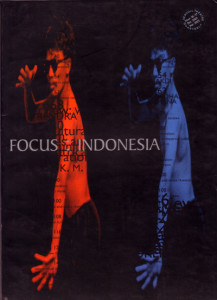January – June 2003. Focus: Indonesia. Editor: Anjum Katyal
What was strange was the lack of strangeness. There was the heat, and the stickiness of clothes on a sweaty body. There were known words that gleamed suddenly lucid in sentences in the unknown tongue. There were eateries/dhabas on the pavements. There were middle-class residential colonies that could have been Delhi or Bangalore. There was the all-too-familiar irony of international brand names and designer stores alongside makeshift shanty settlements. There was the politeness to us strangers, the hospitality to guests, the deference to elders and seniors, the razor-sharp critique of the social commentator, the spicy curries with rice, the hand crafts that echoed this subcontinent and spoke of people-to-people connections stretching back and forth over centuries: filigreed silver, handwoven textiles, batik, carved wood, bamboo and cane basketwork. One could continue. Green coconuts, Ravana–Rama–Sita, powercuts. Indonesia was both familiar and unfamiliar, there were connections and resonances. And when the theatre artists sat with us to talk of their work, there was a passion we recognized, a basic belief that theatre mattered, that communication through performance could make a social difference. And this, more than anything else, spoke to us of home. A gracious ‘colonial style’ theatre, vaulted, corridored and columned, hung with posters and black and white photographs of milestone productions, and a proscenium stage on which, in a mix of traditional form and western theatre style which is deeply familiar, a narrative unfolds of a mythical hero who descends to earth whenever the people, in despair, turn to him for help. There is satire, social commentary, and the use of traditional body movements, choreography, music, costume. The members of the audience, as at similar productions at home, appear to be friends and aficionados, fellow theatre people, they know and greet each other, there is a sense of being comfortable and familiar with the space, with the fare on offer, much like the atmosphere in Academy of Fine Arts, Calcutta or the NSD complex in Delhi or the NCPA or Prithvi in Mumbai. A sense of a circle, of being within the circle. We visit the home of a theatre veteran, in whose courtyard his group rehearses: gracious hospitality, warm-ups and excercises, discussions about props and costumes—which are being readied by the group itself—the air of a team of people working together willingly under a respected leader. Once again, a familiar scenario. Away from the urban congestion, enfolded in green trees and fields, a stilt house where one of the senior most theatre personalities resides, surrounded by memorabilia and testimonies to a formidable reputation. On this small estate, vegetables and fruit are grown by the theatre workers, rehearsals are held, water is drawn from a well and earth is tilled. The master points out the spot where he has chosen to be buried. He talks traditional philosophy, the dreams of a nation imagining itself into life. In complete contrast, we enter the small compound of a low house where, in the darkening dusk, a group of young men and women gather after work, deeply political, sharply analytical, focusing their energies on workshopping a movement which will be part of a larger piece. Highly-trained physiques, intense concentration, uninhibited physicality, sophisticated imagery. This is avant-garde work, informed, thoughtful, precise. It is exhilarating, as is the conversation, which homes in on contemporary issues and concerns from a grounded, self-confident perspective. What were we doing there? Attempting to make connections. With theatre practitioners in Indonesia. Piercing the bland curtain of non-information and non-communication that veils their theatre world from ours. Learning, asking, discussing, observing. In the hope that it will lead to increased interaction and exchange between our respective theatre worlds, to the enrichment of all.
CONTENTS Editorial Anjum Katyal What Indonesia Was, What Indonesia Is: On the Idea of Indonesia Goenawan Mohamad Culture and Society in New Order Indonesia: From the Introduction Virginia Matheson Hooker and Howard K. Dick Notes on the Culture of the ‘Reformasi Era’ Michael Bodden Words and Language Bakdi Soemanto An Archipelago Radhar Panca Dahana ‘Land and Water’ W. S. Rendra Multiculturalism: Sources and Opportunities in Theatrical Collaborations Saini K. M. On Collaboration Putu Wijaya Teater Gandrik: Non-confrontational Critique Agus Noor and Indra Tranggono ‘I really want to terrorize the mind’ Putu Wijaya An Urban Folk Theatre? Nano Riantiarno Coming to Terms with Diversity: Teater Garasi Where Ritual Meets Cartoon : Teater Kita Makassar / Lauren Bain ‘One thing is clear—i was born here’ excerpt from an interview: Asia Rampli Prapanca and Is Hakim / Lauren Bain a collective process: yudiaryani Download the complete issue here
